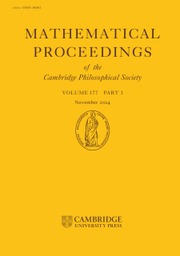Crossref Citations
This article has been cited by the following publications. This list is generated based on data provided by Crossref.
Lim, Meng Fai
2015.
A remark on the 𝔐H(G)-conjecture and Akashi series.
International Journal of Number Theory,
Vol. 11,
Issue. 01,
p.
269.
DELBOURGO, DANIEL
and
LEI, ANTONIO
2016.
Non-commutative Iwasawa theory for elliptic curves with multiplicative reduction.
Mathematical Proceedings of the Cambridge Philosophical Society,
Vol. 160,
Issue. 1,
p.
11.
Kundu, Debanjana
2021.
Growth of Selmer groups and fine Selmer groups in uniform pro-p extensions.
Annales mathématiques du Québec,
Vol. 45,
Issue. 2,
p.
347.
Lim, Meng Fai
2022.
On order of vanishing of characteristic elements.
Forum Mathematicum,
Vol. 0,
Issue. 0,



